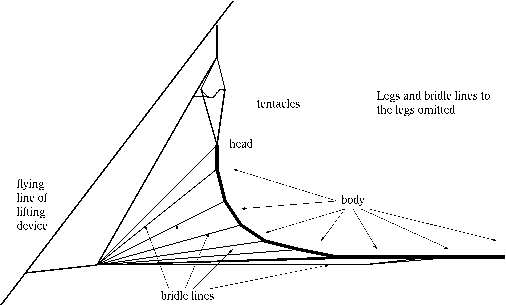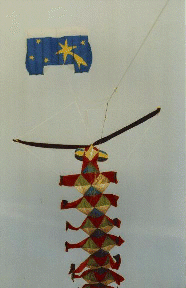
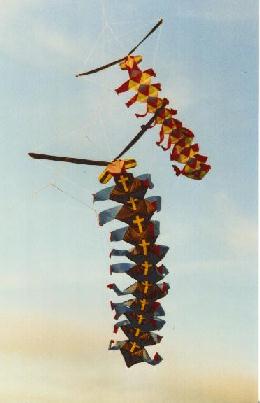
Fig. 1: Pictures of the Centipede
Building a centipede has long been on my wish list of new projects. One of the favourite kites for this purpose was a soft-centipede, like the one that is built and sold by Peter Lynn.
The reason that I did not dare to build one had always been the complexity of this kite. After the Fanø meeting of 1994 I decided to take a closer look at this kite and I found out, that the kite is built out of lots of triangles with only two different sizes. I again was impressed by the genius of Peter Lynn, who has invented a kite, that looks very nice and complex, but is very easy to build and where you even can use scrap pieces of ripstop.
The following is a plan of my version of a soft centipede. I can not call it an original design, because it is built after the centipedes of Peter Lynn. This plan is published with permission of Peter Lynn (Thank you, Peter). It may be freely copied and distributed by anyone. It may not be reprinted in any magazine without my permission.
This plan may not be used to produce the centipede commercially!
The centipede is a line toy, i.e. it will not fly on its own. The centipede is connected to the flying line of a lifting device. For the lifting device, a parafoil, flowform, rokkaku or 3D-box can be used. When choosing a lifting device make sure that it generates enough lift - even the small centipede generates a lot of drag!
Quoting from a letter from Kirri Lynn: `Peter Lynn made this type of kite about ten years ago. It was the first large inflatable he made. (He was having problems with excess weight on planes so he decided to build something that wouldn't have so many sticks.)'
It may also be of interest that Peter developed at least two different types of the centipede. Besides the version that I am going to describe right now, there is also a version of the centipede without the tentacles, but with only a spar that spread the first pair of legs.
Before starting to cut buy or cut or sew anything, please read the plan. Some details in the plan might not be obvious from the beginning. It is difficult to explain all details without the help of pictures.
For the small (approx. 3m long) version of the centipede you need ripstop in
six different colors. According to my version these are: red and blue
for the main body and white and green for those parts of the
body, where the legs are
attached. The legs are made of red and black ripstop and for the eyes you need
small pieces of blue and yellow ripstop. You can choose nearly
any other combination of colors, but for understanding the plan and
the way, the different parts are sewn together, I use these colors as
reference. As mentioned above the body consists of isosceles triangles
(triangles with two equal length sides).
Figure 2 shows one segment of the body.
The amount of ripstop is
measured for a centipede with ten legs on each side. The size of the
triangles was chosen so that you can use normal wide ripstop
(104cm or 41") and get 8 triangles out of a stripe of 25cm. You can
of course also use scrap pieces. Additionally you
need mesh (25cm x 25cm) for the air inlet at the front of the head
and two spars for the tentacles. As I had some old
spars of carbon, I used those which is certainly an overkill. For the
tips of the legs and the sleeves for the tentacles, you need some more
black ripstop (refer to the dimensions given in the drawings).
All in all you need: This plan describes the small version of the centipede with ten legs on each
side. It is
identified by the flat legs of the centipede which are only made by one
single piece of ripstop. If you plan to make larger versions of the
centipede, you should make the legs out of two layers of a
patchwork of small triangles to make it hollow similar to the
body, so that they can also be filled with air. The dimensions in fig. 2 are shown without
any seam allowance. If you
use them, then always add 6mm to each side. I did not use the seam
allowance. Instead I marked a distance of 6mm at the side of the foot
of the sewing machine and therefore made all seams
exactly 6mm inside of each side. I have hot-cut all the triangles. For some kites it is possible to simply
cut the ripstop with scissors if you make always a double seam. For
reasons of simplicity I have decided to only make simple seams and
therefore it is better to hot cut the pieces. You need 22 red, 22
blue, 40 white and 40 green triangles for the body and the legs.
For the throat you need another two red triangles. Each leg is made
out of one piece of red and one piece of black ripstop (that makes
20 red and 20 black pieces). After you have cut out all the triangles for the body, sew panels
together along the diagonals: white with green
and red with blue as shown in Fig. 3 (upper part). Please
make sure, that all seams are on the same
side. Then sew two green/white parts together as shown in
fig. 3 (left side/lower part).
Up to this point, all of your parts should be identical.
With half of the green/white parts, you sew a short side
of one red triangle of a red/blue square to the short side of the green
triangle of the white/green square. Do the same on the other side of the
white/green square so that you end up with a long rectangular piece of
eight pieces of ripstop (again see fig. 3, left side/middle
part). At the end, you should have 10 pieces of the green/white patchwork and
ten pieces of the white/green/red/blue patchwork. Please note: The more carefully you work, the easier is the
whole sewing, especially when sewing the sixth triangle to one point.
Good news for the lazy ones (like me): This kind of patchwork is very
forgiving: Not sewing carefully only results in a little bit more
difficult work. The result of both ways of working is more or less the
same. After having prepared all the different pieces of triangles and legs,
it is now time to finish the body. The small green/white rectangles
are used for the left side of the body and the long
green/white/red/blue ones build up the right side. Now start finishing
the left side of the centipedes body. Take the white/green parts, fold them
along the seam between the two white parts and sew
the green parts together (see fig. 3, right side).
Make sure that the seams
are all on one side. In between
the green parts, add a leg (see fig. 4 / left side). The
legs should be a little bit smaller than the corresponding opening in
the body. This makes it easier to sew the legs in place. Be
sure to sew the leg in the right way in between the green parts,
because otherwise, the leg is not perpendicular to the body but
parallel. A small hint: the end of the tip of the leg must be at
the top (in the direction of the head) and - in my color
scheme - the white triangles are
in the direction of the tail, and green ones in the direction of the head.
So start by sewing the above mentioned tip to the place where the
other six triangles meet (see fig. 4). If you think, that I lay too much stress on this topic, you are
invited to remove the seams from 20 parallel legs from the next centipede that
I am going to make... Now sew the right side of the segments. Take the long rectangles and
again fold them along the white/white seam. Sew a leg in between the
free short side of the green rectangles. Again be aware to sew in the
legs perpendicular, not parallel to the body. Do not sew any seam on
the blue rectangle. These are later on used to connect the different
segments to the whole body. If you have any difficulties in figuring out, which part has to be sewn to
which other part, lay the whole ripstop on the ground and check it. Please note that the black triangles at the outer tip of the legs are still
missing. They are attached to the legs, when the whole body is already
assembled. The reason for this is that one part of the bridle, that connects
the different legs is sewn into the seam between the green and the black
part and it is easier to do this, when all legs are already attached to
the body. Now you can go on by making the real tail: sew together the
remaining two pieces of red/blue ripstop by sewing the short sides of
the red parts of the front and the back together. The next steps must be done for each
of the ten next segments. Start by sewing the right white part of the next
segment to the blue part of the just finished segment on front and
back side. Go on by sewing one white part of the left part of the
next segment to the remaining side of the blue segment on the
corresponding side of the centipede (see fig. 4).
Close the body by sewing the
green parts to the red parts. And continue with the next segment. For the throat, the connection between body and head, you need two other red
triangles. Fold one red triangle in the middle and sew it
with a short side to a blue
triangle from the body. Sew the other short side of the red triangle to the
blue triangle of the back side of the body. Do the same with the other red
triangle (see fig. 5). Now hot cut 20 pieces of black ripstop according
to fig. 2. Sew these
triangles to the outer tip of the red legs. Make a double seam and when
making the second seam, use a zig-zag stitch to also attach the bridle line
to the legs (see fig. 6). One bridle line is used to
connect one leg the next one. The
other one is used to connect one leg on the left with the corresponding
leg on the right side and the bridle line to the centre of the body. Now it should be clear, why the black parts of the legs are only now sewn to
the red parts: Start at the first leg at the head of the centipede on the
right side and work
on with the second, third and always sew the bridle line from one leg to the
next (lines G in fig. 11). Continue with the legs
on the left side. The distance between each leg
is 17cm. I have not marked the 17cm on the bridle line before, but I have
marked this distance on the table, where my sewing machine stands on. When I had
sewn the bridle line into the hem between red and black part, I marked a
distance of 17cm on the bridle line. Then I laid the bridle into the hem of
the next leg, so that the marker on the bridle line was just at the beginning
of the hem. I fixed the bridle line to the leg with a zig-zag stitch.
Once you have sewn all lines between the legs at their place, you can
right now sew the bridle lines E to the tip of each leg. Make
an overhand knot in the middle of line E and (later on) attach the line
F to it. Then attach one end of the bridle line H to each
of these points. Bridle line H is afterwards connected
to the flying line (see below). For the dimensions of the lines, please
refer to table 1. Although the head of the centipede looks three-dimensional when it
is flying, if you lay it to the ground it is flat. The eyes of the centipede are done the same way as with the octopus:
you need four blue pieces and four yellow pieces for each of the two
eyes (see fig. 7-1 and fig.
7-2). The following steps have to be repeated
for all eight pieces and take the blue and yellow pieces alternating:
Sew one piece to the next by making one seam from the top to the right
side. Then sew the next
piece to the back of the previous. Go on
until you have sewn all the eight pieces together. Now cut the
remaining part of all squares away. Turn the whole eye to the right
side.
Fig. 2: One Segment of the Body
The Material
Some Preparation
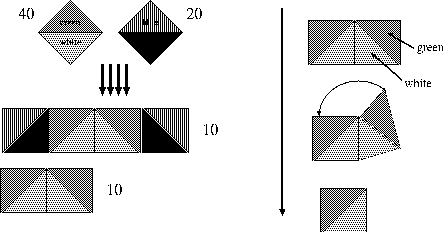
Fig. 3: Sewing the `Building Blocks' of the Body
Patchwork
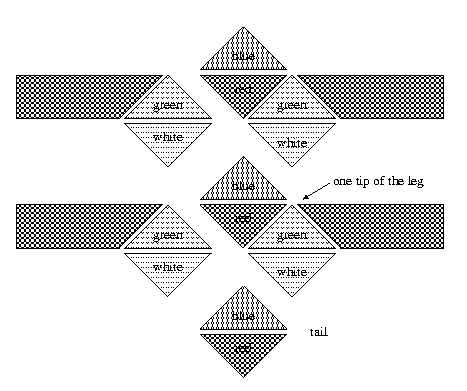
Fig. 4: Building the body from two parts
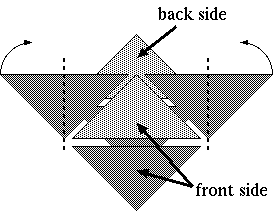
Fig. 5: Sewing the Throat

Fig. 6 How to Sew the Bridle Line to the Legs
The Head
The Eyes
Fig. 7-1: The Eyes of
the Centipede (1) (GIF: 4k)
Fig. 7-2: The Eyes of
the Centipede (2) (GIF: 4k)
The Tentacles
Fig. 8 (GIF: 22k)
One tentacle consists of one long sleeve of black ripstop with another small sleeve inside for the spar (see fig. 8, detail F). The following instructions have to be repeated for both sleeves! Start by sewing two pieces of dacron to the sleeve (see detail A). Make two additional seams to the upper end of the sleeve (see detail A top/middle). Cut the sleeve (and the dacron) in the middle (see detail A). This cut will afterwards be inside of the big sleeve and is used to slip the spars into the small sleeve. Fold the whole ripstop so that the dacron is now on the inside.
Sew a velcro strip to the outside side of the top of the sleeve (detail B). Make a seam that forms the small sleeve for the spars (detail C). Sew a small loop of ripstop to the ends of the sleeve and one to the top. In fig. 8 these ripstop loops are shown on the outside of the sleeve to make the position clearer to the reader. Make sure that you sew them inside of the sleeve. They will later on come automatically to the outside when you turn the whole sleeve from the left to the right side. To this loop, the bridle line C which holds the legs in place is attached. Sew a small loop of ripstop to the side of the sleeve. Close the sleeve at the top (see fig. 8). Now the sleeve should look like it is shown in detail D. Turn the sleeve to the right side.
Cut two spars so that they fit tightly into the inner sleeve. As I had some old carbon spars laying around I used them. I have also tested it with 10mm ramin spars.
The Eyes and the Air Inlet
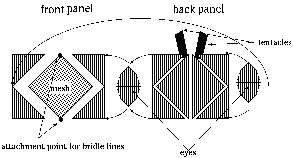
Fig. 10: The Head
The head consists of the mesh for the air inlet, two eyes, the tentacles and some "patches" to keep everything together (see fig. 10).
Sew the mesh from the inside to the four triangular patches at the side of the air inlet. These triangles have the size of just the half of one of the triangles that were used for the body. Then sew the eyes to the sides of this mesh/ripstop combination according to fig. 10. Please note, that in the figure the eight segments of each eye are drawn with a straight line, although in reality they will be slightly curved. Close the head by sewing the ``back panel'' to the sides and to the top of the front side. The back panel consists of two normal size triangles and four half size triangles.
When closing the upper part of the head, do not forget to also sew the finished tentacles in-between the front and back panel just in the middle of the head.
Later you have to attach a bridle line to the top of the air inlet and to the bottom of it (lines D) in fig. 10). Reinforce those places the same way as the part of the body, where the central bridle line is attached (see fig. 12).
Now sew the finished head to the body. Start at the front and make sure, that the head is right in the middle. The front side is the side with the mesh... On the back side I have used a velcro strip to attach the head to the body, so that I can always ``open'' the body to make corrections.
If you do not use this velcro strip, you should add the bridle line enforcements and the sleeves for the tentacles before closing the body...
The Bridle
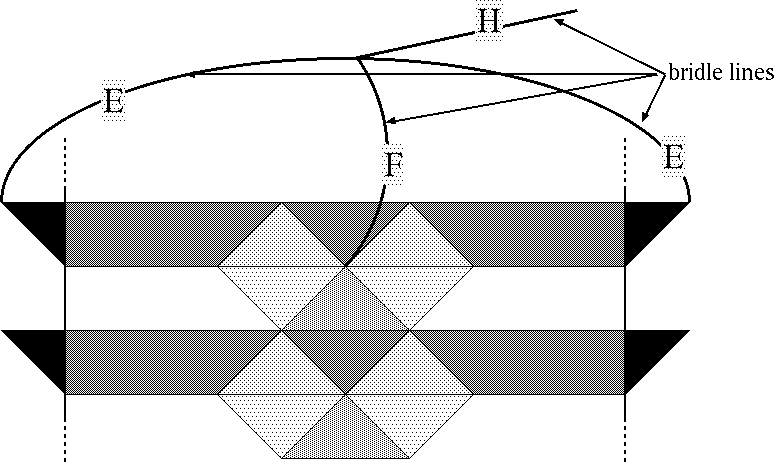
Fig. 11: The Bridle to the Body and the Legs
The bridle of the centipede is different than most other kites. There is not only one point, where the bridle is connected to the flying line, but the bridle consists of a 655cm long flying line with two attachment points, which is afterwards itself connected to the main flying line (of the lifting device as shown in fig. 13). Each segment of the body is connected via three bridle lines: one to the centre of the body segment and one to each leg-tip (see fig. 11). These three lines are connected to one single point. All the bridle lines from the segments/legs are then connected to one other bridle point.
Then there is the head. The tentacles are not there only for cosmetic reasons but are also used to spread the legs. The angle of attack of the whole centipede changes from the head to the tail: The head is relatively upset, whereas the tail of the centipede is flying almost parallel to the ground. This is done for several reasons. The head must be upset, because it would not be filled with air otherwise. The tail is nearly parallel to the ground because it acts as a stabilizer for the whole kite.
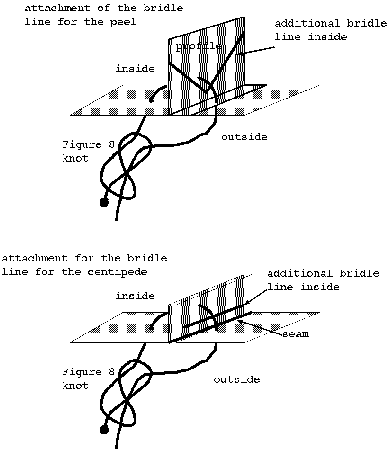
Fig. 12: Attaching the Bridle Line to the Body
For the connection of the bridle lines to the body, I have modified a little bit the method that Andrew has recently described for the peel. In fig. 12 both methods are shown: The way the bridle line is attached to the peel in the upper part, and the way I am going to describe right now in the lower part.
As I do not have any profiles in the centipede, the seam allowance must play the part of it. I have sewn a piece of bridle line onto the seam allowance inside of the kite. Quoted directly from Andrews posting: "To attach a bridle line to the reinforcement, use a needle with a handle. Thread some spectra (or something strong and thin) through the needle and tie both ends to the handle. Stick the needle through the body skin, the seam allowance (just above the line) and back through the skin, keeping the holes as close together as possible. Thread the bridle line through the loop of line in the needle and pull it through."
Then make a figure-8 knot to attach the end of the bridle line to itself. The length of the bridle lines H to the different segments is shown in tab. 1.
